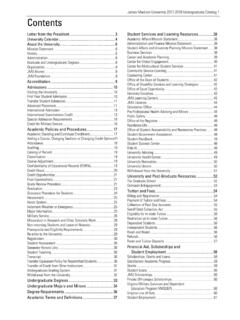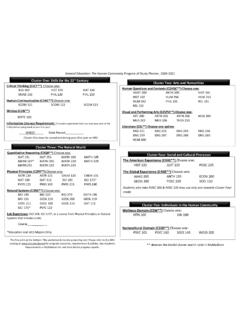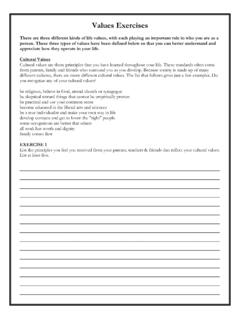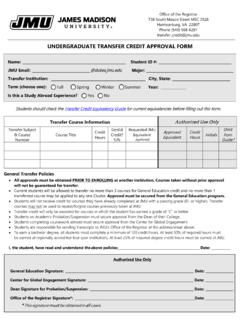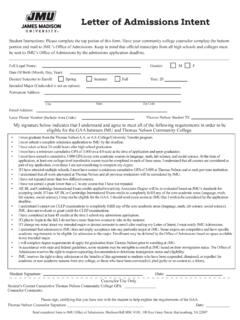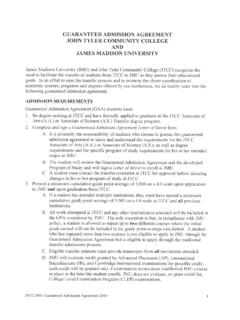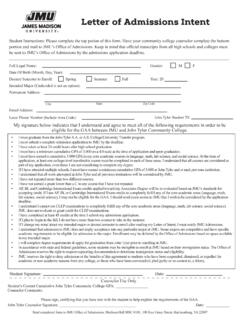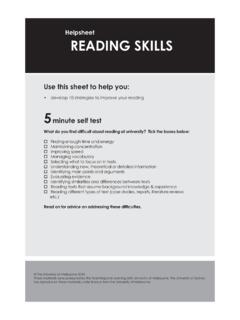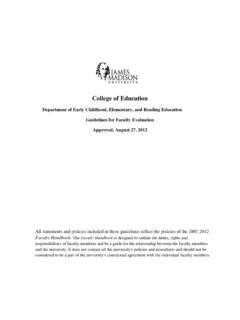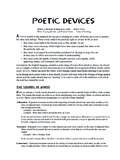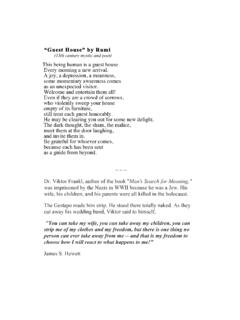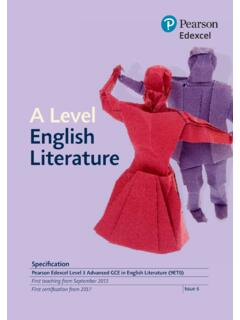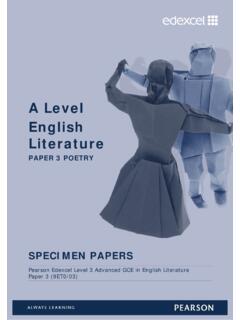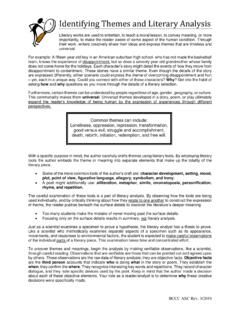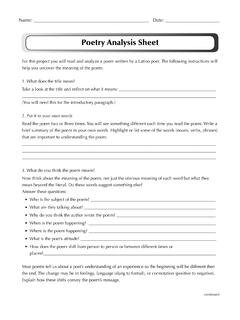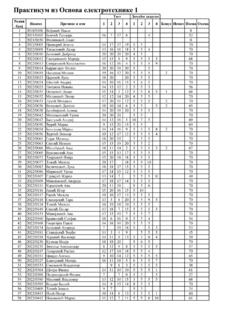Transcription of MSL 202, Lesson 15: Writing in the Army Style ... - JMU
1 MSL 202, Lesson 15: Writing in the Army Style Revision Date: 31 March 2017 Army Memo collage Writing in the Army Style MSL 202, Lesson 15: Writing in the Army Style Revision Date: 31 March 2017 BUFORD S MESSAGE TO REYNOLDS GETTYSBURG (1863) MSL 202, Lesson 15: Writing in the Army Style Revision Date: 31 March 2017 Learning Objectives Describe the Army Writing standards IAW AR 25-50 Explain the meaning and importance of BLUF Understand how to write in the active voice Explain the steps in the Writing process MSL 202, Lesson 15: Writing in the Army Style Revision Date: 31 March 2017 Army Leadership Requirements Model ADP/ADRP 6-22 MSL 202, Lesson 15: Writing in the Army Style Revision Date: 31 March 2017 Army Writing Style Guide BLUF: Bottom Line Up Front: Put the recommendation, conclusion or reason for Writing -- the bottom line -- in the first or second paragraph, not at the end Use the active voice Concise, organized, to the point Use correct spelling, grammar, and punctuation Write in the first person using I, you and we as subjects of sentences instead of this office, this headquarters, all individuals, and so forth, for most types of Writing Convey a clear message in single, rapid reading Use Respectful, Professional Tone MSL 202, Lesson 15: Writing in the Army Style Revision Date.
2 31 March 2017 Spell Check Poem Spell check is only a tool and is not infallible, AR 25-50 The Spelling Chequer (or poet tree without mist takes) Eye have a spelling chequer It came with my pea sea It plainly marks four my revue Miss steaks eye cannot see Each thyme when I have struct the quays Eye weight four it two say If watt eye rote is wrong or rite It shows me strait a weigh As soon as a mist ache is maid It nose bee fore too late And eye can put the error rite Eye really fined it grate I've run this poem threw it I'm sure your policed to no It's letter perfect in its weigh My chequer tolled me sew - Author Unknown MSL 202, Lesson 15: Writing in the Army Style Revision Date: 31 March 2017 Army Writing Standards Bottom-Line-Up Front (BLUF) Straight to the Point Clear and Concise Explain Reasoning After BLUF MSL 202, Lesson 15: Writing in the Army Style Revision Date: 31 March 2017 Active Voice It is a stronger form of expression because it indicates the Agent and shows the action It states the action in fewer words It prevents confusion about the actor.
3 Use of I and We; the first person takes responsibility for the action PASSIVE - The subject of the sentence names the receiver of the action. ACTIVE -The subject of the sentence names the receiver of the action PASSIVE = RECEIVER ---VERB --- DOER All weapons will be zeroed before qualification. ACTIVE = DOER --- VERB --- RECEIVER All qualifiers will zero their weapons before qualification. MSL 202, Lesson 15: Writing in the Army Style Revision Date: 31 March 2017 Active Voice (cont.) NOT: Three teams were BUT: LTC Jones formed three NOT: A TDY is requested BUT: LTC Jones requests a NOT: The M4 was fired by PFC BUT: PFC Smith fired the NOT: The M4 was fired by PFC BUT: PFC Smith fired the M4 NOT: The HMMWV was wrecked by PVT Jones. BUT: PVT Jones wrecked the HMMWV MSL 202, Lesson 15: Writing in the Army Style Revision Date: 31 March 2017 Practical Exercise Instructions: 1) Divide the class into groups of 3-5 Cadets.
4 2) Distribute PE to each group 3) Have the groups review the PE and determine and rewrite the sentence into active voice if applicable. 4) Allow Cadets 3-5 minutes to complete the PE 5) Have one Cadet from each group present and explain their responses MSL 202, Lesson 15: Writing in the Army Style Revision Date: 31 March 2017 The Elements of Effective Writing Substance Control and support of your idea; most important element Organization clear and concise; flow Style format, vocabulary, package Correctness grammar, spelling MSL 202, Lesson 15: Writing in the Army Style Revision Date: 31 March 2017 Five Step Writing Process # 1 Step 1: Research - Research is the gathering of ideas and information. This is the step where you answer the "who, when, where, what, and how of the issue". Since we gather information in different ways, you must find the system which best suits you and your task. Ensure you document your sources. MSL 202, Lesson 15: Writing in the Army Style Revision Date: 31 March 2017 Five Step Writing Process # 2 Step 2: Plan- The planning step is where you take all the information you ve gathered and put it into a logical order.
5 Start by placing your ideas into groups. Then order your groups in the way that best supports your task. The product that results is the outline. MSL 202, Lesson 15: Writing in the Army Style Revision Date: 31 March 2017 Five Step Writing Process # 3 Step 3: Develop a Draft- The draft is the bridge between your idea and the expression of it. Write your draft quickly and concentrate only on getting your ideas down on paper. Don t worry about punctuation and spelling. Use your outline to develop your draft. MSL 202, Lesson 15: Writing in the Army Style Revision Date: 31 March 2017 Five Step Writing Process # 4 Step 4: Revise- Revising is looking at the material through the eyes of your audience. Read the paper as if you have never seen it before. Find where you need to put in transitions; look for places that need more evidence. This will help you decide if you need to add enclosures or add information depending on the type of written product you are developing.
6 MSL 202, Lesson 15: Writing in the Army Style Revision Date: 31 March 2017 Five Step Writing Process # 5 Step 5: Proof- Now you are ready to proof your draft. At this point concentrate on the format, grammar, mechanics, and usage. You may want to have someone else read it. Sometimes others can find errors you can t because you are too close to the product. When you finish, write the final version, making the corrections. MSL 202, Lesson 15: Writing in the Army Style Revision Date: 31 March 2017 The Standard ELEMENTS PROCESS STANDARD Substance Organization Step 1 - Research Step 2 - Plan Step 3 - Draft Transmits a clear message in a single rapid Style Correctness Step 4 - Revise Step 5 - Proof ..generally free of errors in grammar, mechanics, and usage MSL 202, Lesson 15: Writing in the Army Style Revision Date: 31 March 2017 Written Communications Major Types Memorandums Operations Orders (OPORDs) Endorsements MSL 202, Lesson 15: Writing in the Army Style Revision Date: 31 March 2017 Types of Memorandum Formal Memos External to HQ, Command, Installation or DOD Personnel actions Appreciation and Commendations Informal Memos Internal to HQ, Command, Installation, or DOD Special Purpose Memos Memorandum of Understanding (MOU) Memorandum of Agreement (MOA) Memorandum for Record (MFR) MSL 202, Lesson 15: Writing in the Army Style Revision Date: 31 March 2017 Memorandum Format AR 25-50, Chaps, 2-4 Heading Body Closing Heading: The heading has five elements- Heading: Five elements Office symbol Date Suspense date MEMORANDUM FOR line Subject line Body: Begin the memorandum with a short, clear purpose sentence.
7 Put the recommendation, conclusion, or most important information (the main point) next. (Some Writing combines the purpose and the main point.) Clearly separate each major section. Use paragraphs, headings, or sections. When appropriate, a point of contact (POC) line will be the last paragraph of the body of the correspondence. Closing: Major elements are the- Authority line Signature block Enclosure listing MSL 202, Lesson 15: Writing in the Army Style Revision Date: 31 March 2017 Take Home Quiz Work alone Rewrite the statements on each handout using the Army Writing Style Write a memorandum according to instructions on the quiz sheet MSL 202, Lesson 15: Writing in the Army Style Revision Date: 31 March 2017 Closing Review Learning Objectives Explain the meaning and importance of BLUF Understand how to write in the active voice Describe the Army Writing standards IAW AR 25-50 Explain the steps in the Writing process Questions Next Lesson : Subsequent Lesson : CADET POST-CLASS ASSIGNMENT Complete Quiz and turn in prior to next class
